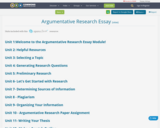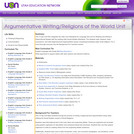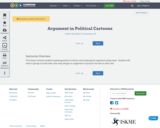
The fundamentals of the argumentative essay (the gateway essay to all college level writing!).
- Subject:
- English Language Arts
- Material Type:
- Lesson Plan
- Date Added:
- 11/24/2018

The fundamentals of the argumentative essay (the gateway essay to all college level writing!).

The fundamentals of the argumentative essay (the gateway essay to all college level writing!).

This module provides instructions on how to write an argumentative research paper.

This resource is designed to walk students through the process of completing a research project in any field of study. It covers the earliest stages of brainstorming and discussing, continues through researching and compiling sources; writing, documenting, revising, and polishing a paper; and finally presenting the research topic to a wider audience in a professional manner. The focus is on MLA format, though the course could be modified for other formats.
The first unit is an introduction to the project. It asks students to draw on knowledge of issues affecting their own community and world to help generate discussion that could eventually lead to a research topic.

This resource is designed to walk students through the process of completing a research project in any field of study. It covers the earliest stages of brainstorming and discussing, continues through researching and compiling sources; writing, documenting, revising, and polishing a paper; and finally presenting the research topic to a wider audience in a professional manner. The focus is on MLA format, though the course could be modified for other formats.
The first unit is an introduction to the project. It asks students to draw on knowledge of issues affecting their own community and world to help generate discussion that could eventually lead to a research topic.

The learner-audience for this lesson are high school international students working on their English research paper. The lesson demonstrates how the successful writing of the “thesis-statement” is essential for writing an effective persuasive essay. The lesson will help prepare learners to write an effective thesis statement which their essay responds to. The lesson shows how a successful thesis statement guides the direction of the rest of the essay and that without an effective thesis statement most essays are difficult to write and to comprehend for the reader. The lesson encourages learners to practice writing thesis statements and to write thesis statements that draw from their own experiences. This can either be taught as a supplement to their English class or as stand alone class.

This mini-lesson focuses on the main parts of creating an argument in writing. This lesson supports the South Carolina College and Career Ready ELA Standard for 7th grade: Writing 1.1.

This lesson is designed to support English language learners when argumentative writing. It is prepared using the topic selected by my students, “Are Social Networking Sites Good For Our Society?” This lesson could easily be adapted to meet other topics of interest. The lesson begins by reinforcing that when one is argumentative writing, the writer must choose a side and have a reason for choosing it. Then, the lesson evaluates others’ argumentative writing to see what it might look like. Afterward, the students have an opportunity to get comfortable with the argumentative writing topic they will be writing about with support of their peers and the teacher. Ultimately, with other support in place, students will write an argumentative piece to the best of their ability with a goal in mind.

This video goes over the basics of a 5-paragraph argumentative paper, including the rebuttal. There are examples for each paragraph (introduction + thesis, body paragraphs, rebuttal paragraph, and conclusion).

This 14 day Unit Plan integrates the Utah Core Standards for Language Arts and for Reading and Writing in History/Social Studies with the existing Utah Social Studies Standards. The students read, research, draw conclusions, and write beginning level argumentative essays comparing/contrasting major world religions. For a more thorough summary see the Background For Teachers section.

In this 28 day unit, students will gain background information on historic wars, compare different genres presentations of events, recognize different points of view, research an essential question, compile evidence, create warrants that lead to a claim which answers the essential question, and write an argumentative essay.

This lesson involves students exploring political cartoons and analyzing the argument being made. Students will work in groups to build skills, then they will get an assignment to practice the skill on their own.

Students will discover a policy within their school or district that is important to them and that they'd like to change. They will conduct an investigation of the policy in question and write a letter with their claim, results, and recommendation to the appropriate audience.

A dramatic portrayal, clearly biased toward the northern point of view, of an incident in Congress which inflamed sectional passions in 1856. The artist recreates the May 22 attack and severe beating of Massachusetts senator Charles Sumner by Representative Preston S. Brooks of South Carolina. Brooks's actions were provoked by Sumner's insulting public remarks against his cousin, Senator Andrew Pickens Butler, and against Illinois senator Stephen A. Douglas, delivered in the Senate two days earlier. The print shows an enraged Brooks (right) standing over the seated Sumner in the Senate chamber, about to land on him a heavy blow of his cane. The unsuspecting Sumner sits writing at his desk. At left is another group. Brooks's fellow South Carolinian Representative Lawrence M. Keitt stands in the center, raising his own cane menacingly to stay possible intervention by the other legislators present. Clearly no help for Sumner is forthcoming. Behind Keitt's back, concealed in his left hand, Keitt holds a pistol. In the foreground are Georgia senator Robert Toombs (far left) and Illinois senator Stephen A. Douglas (hands in pockets) looking vindicated by the event. Behind them elderly Kentucky senator John J. Crittenden is restrained by a fifth, unidentified man. Above the scene is a quote from Henry Ward Beecher's May 31 speech at a Sumner rally in New York, where he proclaimed, "The symbol of the North is the pen; the symbol of the South is the bludgeon." David Tatham attributes the print to the Bufford shop, and suggests that the Library's copy of the print, the only known example, may have been a trial impression, and that the print may not actually have been released. The attribution to Homer was first made by Milton Kaplan.|Probably printed by John H. Bufford, Boston.|Signed with monogram: WH (Winslow Homer).|Title appears as it is written on the item.|Tatham, "Pictorial Responses to the Caning of Senator Sumner," p. 15-16.|Forms part of: American cartoon print filing series (Library of Congress)|Published in: American political prints, 1766-1876 / Bernard F. Reilly. Boston : G.K. Hall, 1991, entry 1856-1.|Exhibited: American Treasures of the Library of Congress.

This video will explain the case for protectionism. This 14 minute video will enforce standards EPF. 9 and particularly EPF. 9 (e).

An Introduction to Critical Thinking
Short Description:
Arguments in Context is a comprehensive introduction to critical thinking that covers all the basics in student-friendly language. Intended for use in a semester-long course, the text features classroom-tested examples and exercises that have been chosen to emphasize the relevance and applicability of the subject to everyday life. Three themes are developed as the text proceeds from argument identification and analysis, to the standards and techniques of evaluation: (i) the importance of asking the right questions, (ii) the influence of biases, cognitive illusions, and other psychological factors, and (iii) the ways that social situations and structures can enhance and impoverish our thinking. On this last point, the text includes sustained discussion of disagreement, cooperative dialogue, testimony, trust, and social media. Overall, the text aims to equip readers with a set of tools for working through important decisions and disagreements, and to help them become more careful and active thinkers.
Long Description:
Arguments in Context is a comprehensive introduction to critical thinking that covers all the basics in student-friendly language. Intended for use in a semester-long course, the text features classroom-tested examples and exercises that have been chosen to emphasize the relevance and applicability of the subject to everyday life. Three themes are developed as the text proceeds from argument identification and analysis, to the standards and techniques of evaluation: (i) the importance of asking the right questions, (ii) the influence of biases, cognitive illusions, and other psychological factors, and (iii) the ways that social situations and structures can enhance and impoverish our thinking. On this last point, the text includes sustained discussion of disagreement, cooperative dialogue, testimony, trust, and social media. Overall, the text aims to equip readers with a set of tools for working through important decisions and disagreements, and to help them become more careful and active thinkers.
Word Count: 96327
(Note: This resource's metadata has been created automatically as part of a bulk import process by reformatting and/or combining the information that the author initially provided. As a result, there may be errors in formatting.)

Arham Garbh Sanskar: A Guide for Prospective Parent to Impart the Best to Their Unborn Child

Ariolimax columbianus: Information

Arion ater: Information

Signed in stone: J. Cn.|Title appears as it is written on the item.|Forms part of: American cartoon print filing series (Library of Congress)